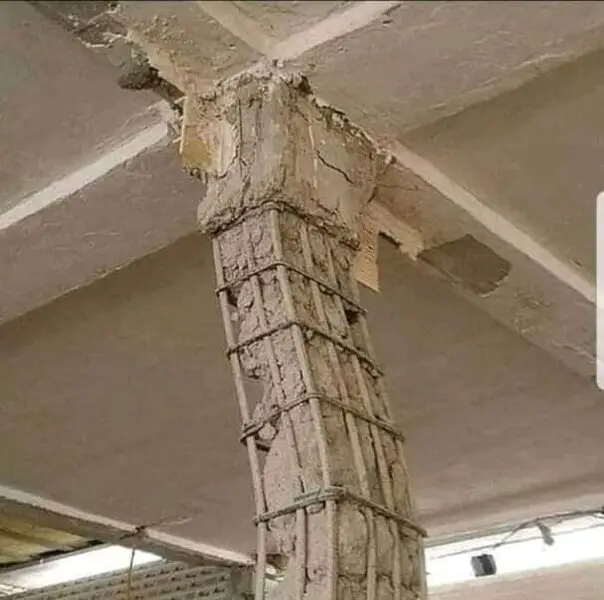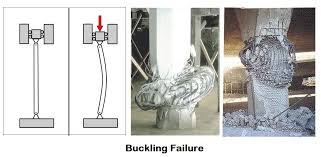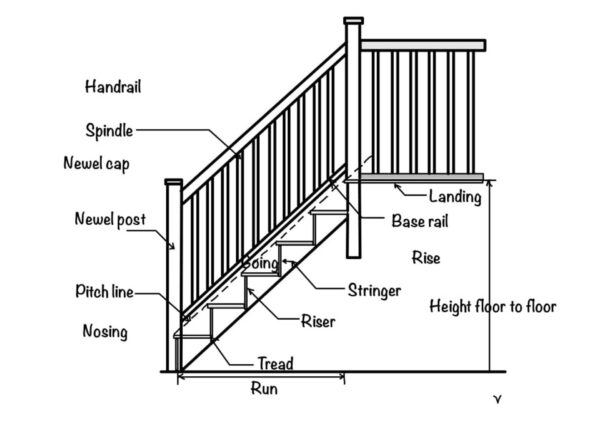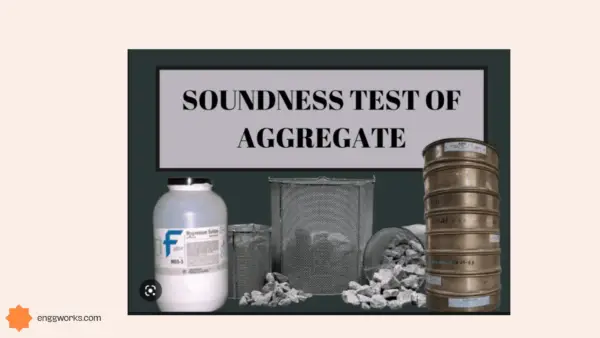Column is a very important structural component that boosts the structural integrity . It transfers the load from the structure to the ground through foundation. The entire stability of structure lies on how perfect the column is designed and constructed.
When designing structures, understanding column failure is crucial to ensure the safety and stability of the building.
Columns, being vertical structural elements, are subjected to various loads and stresses that can lead to different types of failure. Two primary modes of column failure are crushing and buckling, which are influenced by the column’s slenderness ratio and material properties.
Long columns fail due to buckling, a phenomenon that occurs when the column’s axial compressive load exceeds its critical buckling load.
This causes the column to deflect laterally, leading to instability and potential collapse. On the other hand, a short column fails by crushing when the compressive stress exceeds the material’s compressive strength, resulting in the column’s inability to support the load.
The failure of the reinforced concrete column leads to the failure of the whole structure. So It is very important to identify the column failure in advance if any and take necessary remedial steps to eradicate them.
If the column failures are not checked at regular intervals this may lead to collapse of the entire structure. Failure in the column occurs for many reasons.

Column Failure Reason
- Excessive loading: When the applied load exceeds the design capacity of the column, it can cause buckling, crushing, or shear failure.
- Material defects: Flaws in the material or fabrication of the column, such as cracks, corrosion, or low quality concrete, can reduce its strength and durability.
- Environmental effects: Exposure to harsh weather conditions, such as moisture, temperature changes, or earthquakes, can damage the column and its connections.
- Design errors: Mistakes in the design or construction of the column, such as inadequate reinforcement, insufficient cross-section, or improper alignment, can lead to failure.
Other than these common causes there are few specific structural reasons that tend the column member to fail.
This article gives a detailed description of different modes of failure occurring in the column , their reason for failure and prevention measures.
Column Failure Modes
Column failure modes are the ways in which a column can lose its ability to support a load.
To understand the modes of failure in column, it’s essential to consider factors such as the column’s length, cross-sectional area, and material properties.
In the case of a steel column failure, local buckling of the flanges or web can occur due to high compressive stresses, while global buckling affects the entire column’s stability.
Analyzing the failure modes of axially loaded columns helps engineers and architects design safe and efficient structures.
To minimize the risk of column failure, they employ various strategies, such as using appropriate materials, optimizing cross-sectional shapes, and implementing lateral bracing systems.
Columns are structural elements that are designed to resist compression forces, but they can also be subjected to bending, shear, and torsion. Depending on the material, geometry, and loading conditions of a column, different failure modes can occur.
Some common column failure modes are:
- Buckling: This occurs when a column becomes unstable under compressive load and bends out of its original shape. Buckling can be prevented by increasing the stiffness or slenderness ratio of the column, or by providing lateral support.
- Crushing: This occurs when a column reaches its ultimate compressive strength and collapses. Crushing can be prevented by increasing the strength or cross-sectional area of the column, or by reducing the applied load.
- Shear failure: This occurs when a column fails due to shear stress, which is perpendicular to the longitudinal axis of the column. Shear failure can be prevented by increasing the shear strength or shear reinforcement of the column, or by reducing the transverse load.
- Torsional failure: This occurs when a column fails due to torsional stress, which is twisting around the longitudinal axis of the column. Torsional failure can be prevented by increasing the torsional strength or torsional reinforcement of the column, or by reducing the twisting load.

Column failure modes are important to understand for engineers and architects who design and construct buildings and structures. By knowing the possible failure modes of a column, they can choose the appropriate material, geometry, and loading conditions to ensure safety and stability.
Column Failure Types
Columns are the vertical load carrying members that take axial compressive loads from the superstructure.
Column failures are one of the most common and dangerous structural problems that can occur in buildings. It may be due to many reasons.
One main cause for failure is slenderness ratio, which is the ratio of its effective length to its least lateral dimension. Slender columns tend to fail by buckling, while short columns tend to fail by crushing.
Based on slenderness ratio there are three types of failures majorly observed in the rcc columns, they are ,
- Pure compression failure
- Buckling failure
- Shear failure
Compression failure
This type of failure usually occurs due to the development of the compressive stresses greater than the allowable stresses.
When the columns are loaded axially the steel and the concrete in the column experience some stresses.
When the load on the column is further increased and reaches greater amounts than the cross sectional area of the column then the steel and concrete will reach the yielding stress leading to the failure without later deformation.

It is majorly observed in short and wider columns. In this mode of failure, the column does not collapse directly but the material itself fails by crushing or yielding.
The three main factors responsible for this type of failure are loading, compressive strength of the materials, and cross-sectional area of the column.
To avoid this type of failure, overloading of the column to be avoided, cross-sectional area column provided depending on the loading conditions, and finally the stresses developed due compressive strength in the column should be less than that designed for the column.
Buckling failure
This type is usually observed in long or slender columns. For the slender or long columns the least lateral dimension is greater than 12 , and has very less load carrying capacity.
When the load is applied on such columns , the column becomes unstable and may fail showing a sideways bend called column buckling.
This may occur even for very small loads .This means that concrete and steel in the column reaches the yielding stress even for application of small loads showing the failure.

Column buckling can be avoided by not constructing the long columns whose slenderness ratio is greater than 30.
For designing the slender columns special care is to be taken such that the column can resist itself from buckling. If possible it is better to increase the least width of the column to avoid slenderness.
Shear failure
This type of failure occurs when the shear force developed in the column is more than the shear capacity of the column.
The shear load on the column develops sliding failure which in the form of the shear cracks developed in the column along the plane parallel or diagonal to the direction of application of the force.

To resist the shear force developed in the RCC column we have to provide shear reinforcement or tie bars, if they are not adequate to take the shear force then the column may fail.
This type of failure can be avoided by designing the column with required tie rebars to confine the main bars.
Other Column Failure Modes
In accordance with the above modes of failures some other types of failures observed in column are as follows
Failure due to Lack of Confinement Reinforcement
Vertical element subjected to cyclic loadings subjected to failure of this nature.
Failure causes mainly due to the lack of links in the area where there are higher shear forces.
In structural elements such as beams and columns, higher stresses are generated near the connections. Lack of links in these areas causes structural failures when cyclic loadings are applied.

Torsional Failures
There is a probability of columns subjected to torsional moments.
Usually, columns are designed for axial, bending, and shear forces. However, due to the irregularities in the structure, the torsional behavior of the column can be observed.
Columns are torsionally rigid when they are compared with the beam as they have reinforcement around the section and links are provided at closer spacings.
However, if the torque exceeds the limiting values, columns could fail in torsion.
Failure due to the Errors in the Construction
There may be many errors that could happen in construction and they also can be categorized under types of column failure. Employing qualified engineers to the project and close supervision of construction work will minimize these types of column failure.
- Mistakenly reduce the bar diameter
- Construct an incorrect column in the location
- Changes in the grade of concrete
- Lack of strength in the concrete due to the failure of the concrete supplier
Prevention and repair of column failures
How to prevent column failure involves a comprehensive approach that considers factors like proper material selection, accurate load calculations, and adherence to building codes and standards.
By understanding the mechanisms behind column failure and implementing appropriate design measures, professionals can create structures that withstand the test of time and ensure the safety of occupants.
Column failures can be prevented by following good design and construction practices, such as:
- Choosing appropriate materials and specifications for the column and its connections
- Providing adequate reinforcement and cross-section for the column
- Considering the effects of loading and environmental conditions on the column
- Performing regular inspection and maintenance of the column
Repair methods
If a column failure occurs, it should be repaired as soon as possible to restore its functionality and safety. The repair method depends on the type and extent of damage, but some common techniques include:
- Replacing or strengthening the damaged column or its connections
- Applying external jackets or wraps around the column
- Injecting epoxy or grout into the cracks or voids in the column
- Adding supplementary supports or braces to the column






